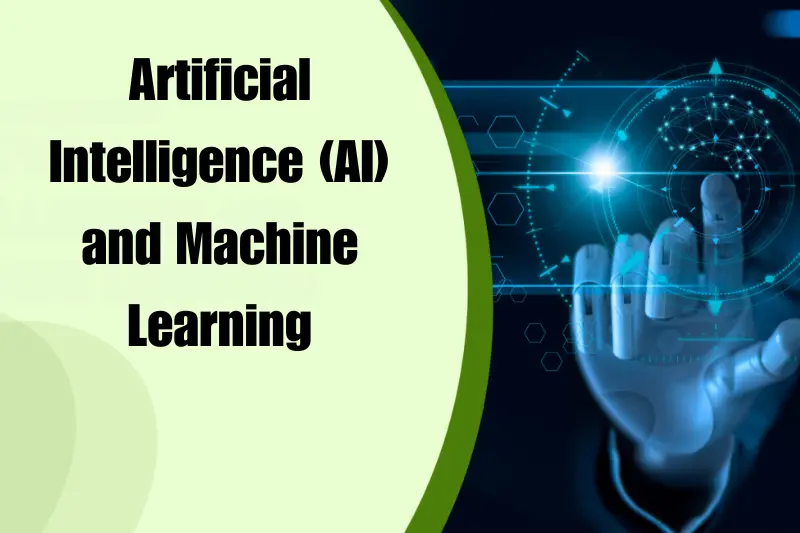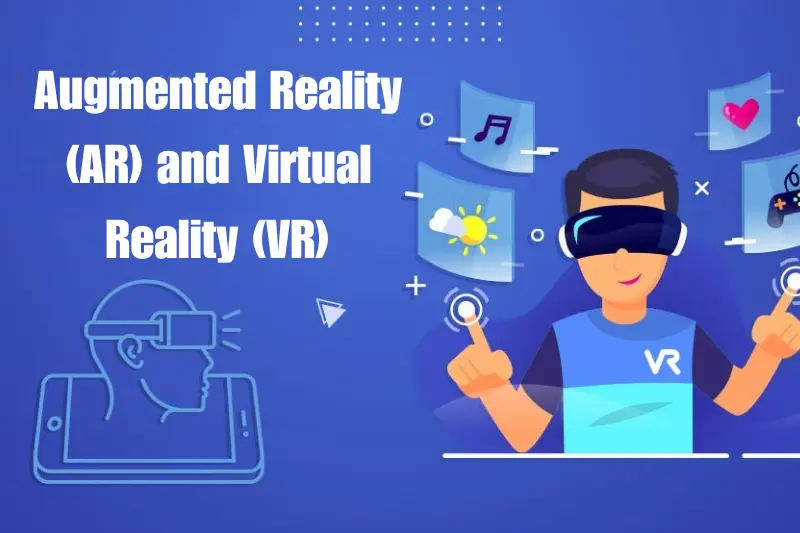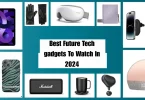In the fast-evolving landscape of technology, innovations are occurring at an unprecedented pace. These advancements are not just shaping industries but also altering the way we live, work, and communicate.
From artificial intelligence (AI) breakthroughs to quantum computing, blockchain applications, and advancements in renewable energy, the latest innovations in technology are pushing the boundaries of what’s possible. Let’s explore these exciting new developments in more detail.
1. Artificial Intelligence (AI) and Machine Learning
 Artificial intelligence continues to be one of the most transformative forces in the tech world. Its capabilities are evolving at a rapid rate, providing solutions to previously insurmountable problems and reshaping entire industries.
Artificial intelligence continues to be one of the most transformative forces in the tech world. Its capabilities are evolving at a rapid rate, providing solutions to previously insurmountable problems and reshaping entire industries.
Generative AI Generative AI refers to systems that can generate new content, from text to images and even code. OpenAI’s GPT models are a prime example, where the AI can write essays, code programs, and produce artwork by understanding patterns from vast datasets. This ability to create original content has widespread applications in creative industries like film, design, journalism, and entertainment, where human-like creativity is now being augmented by AI.
AI in Healthcare AI is making waves in healthcare, particularly in diagnostics and patient care. Advanced algorithms can now analyze medical images with remarkable accuracy, often outperforming human doctors in diagnosing conditions such as cancers, neurological diseases, and heart problems. AI-powered tools are also enabling personalized medicine, tailoring treatment plans to individual patients based on their genetic profiles. This represents a move away from one-size-fits-all treatment, promising more effective therapies with fewer side effects.
Autonomous AI Autonomous systems are another remarkable application of AI. Self-driving cars are becoming more reliable, with companies like Tesla and Waymo leading the charge in AI-powered, fully autonomous vehicles. These systems rely on machine learning algorithms to navigate complex environments, making decisions in real-time based on sensor data. Drones are also following suit, with autonomous drones being used for delivery, surveillance, and agricultural purposes.
Ethical Considerations As AI continues to expand, concerns about its ethical implications are growing. Issues related to privacy, bias, and accountability are at the forefront of discussions. The potential for AI systems to reinforce societal biases has sparked calls for responsible AI development, with new regulations and frameworks being proposed to ensure these systems are fair, transparent, and ethical.
You may also like to read this:
Future Tech Trends 2024: Key Advancements Expected
Next-Gen AI Developments: Trends To Watch In 2025
How Quantum Computing Will Change The World?: A Guide
Top Best Future Tech Gadgets To Watch In 2024 You Need
What Is The Future Of AI And Machine Learning? In 2025?
The Role Of Nanotechnology In Future Tech: Healthcare Impact
How AI Is Shaping The Future Workforce? In 2025
2. Quantum Computing
Quantum computing is another frontier in latest innovations in technology, promising to revolutionize how we solve complex problems. Unlike classical computers, which use bits to process information as either 0s or 1s, quantum computers use quantum bits (qubits) that can exist in multiple states simultaneously. This allows quantum computers to perform calculations much faster than conventional machines.
Speed and Power Quantum computers excel in areas where classical computers struggle, such as simulating molecular structures for drug discovery or optimizing large datasets in logistics. For example, quantum computers could significantly accelerate the discovery of new materials or help solve optimization problems in logistics that would take traditional supercomputers millennia to process.
Cryptography and Security Quantum computers also have the potential to break current cryptographic systems. Traditional encryption methods could be vulnerable to attacks from powerful quantum systems. In response, a new field of quantum cryptography is developing, utilizing quantum mechanics to secure information in ways that classical cryptography cannot.
Current Progress Though quantum computing is still in its nascent stages, companies like IBM, Google, and Microsoft are making significant strides. IBM’s Quantum System One is one of the first commercially available quantum computing systems, providing researchers with access to quantum processing power through the cloud. Although we are still far from mainstream use, the advancements in quantum computing are laying the groundwork for future breakthroughs in fields like medicine, artificial intelligence, and finance.
3. 5G and Beyond (6G)
5G technology is another pivotal latest innovation in technology. It is the next generation of mobile network technology, offering faster speeds, lower latency, and greater connectivity compared to its predecessor, 4G. But even as 5G networks are being deployed globally, the tech community is already looking toward the future with 6G.
5G Impact 5G brings significant improvements in wireless communication. It offers speeds that are up to 100 times faster than 4G, enabling seamless streaming, low-latency gaming, and real-time remote collaboration. The technology also supports a much larger number of connected devices, which is crucial as the Internet of Things (IoT) continues to expand. 5G will also play a key role in enabling AI, autonomous vehicles, and smart cities by providing the infrastructure necessary to support these advanced technologies.
Looking to 6G While 5G is still being rolled out, research into 6G is already underway. Expected to be commercially available by the late 2030s, 6G promises to be exponentially faster than 5G, with data transfer speeds up to 100 times faster. This will enable next-generation technologies such as ultra-realistic augmented reality (AR) and virtual reality (VR), as well as pervasive AI that can operate in real-time without lag. 6G is also expected to integrate seamlessly with other technologies like quantum computing, offering an even greater leap in connectivity and processing power.
4. Augmented Reality (AR) and Virtual Reality (VR)
 Augmented reality (AR) and virtual reality (VR) are transforming how we interact with digital content and the world around us. The latest innovations in technology in this area are pushing the boundaries of immersive experiences, enhancing both entertainment and professional applications.
Augmented reality (AR) and virtual reality (VR) are transforming how we interact with digital content and the world around us. The latest innovations in technology in this area are pushing the boundaries of immersive experiences, enhancing both entertainment and professional applications.
AR and VR in Healthcare In healthcare, AR and VR are being used for training, remote surgery, and even therapy. VR allows medical professionals to simulate complex procedures in a virtual environment, offering invaluable hands-on training without the risk. Meanwhile, AR is enhancing surgeries by overlaying digital information on a surgeon’s view of the patient’s body, improving precision during operations. In mental health, VR therapy is being used to treat conditions like PTSD, anxiety, and phobias by immersing patients in controlled virtual environments.
The Metaverse The concept of the Metaverse is gaining traction, and AR and VR are the foundation for this immersive digital universe. Companies like Meta (formerly Facebook) are investing heavily in the Metaverse, where users will be able to interact with each other and digital objects in a virtual world. This evolution could change how we socialize, work, and even shop, creating new opportunities for entertainment, education, and business.
Enterprise Use AR is also becoming increasingly important in enterprise applications. For instance, in manufacturing, AR is being used to guide workers through assembly processes by overlaying digital instructions onto physical products. In retail, AR is enhancing customer experiences by allowing shoppers to visualize products in their homes before purchasing.
5. Blockchain and Cryptocurrencies
Blockchain technology is revolutionizing industries beyond its initial use in cryptocurrencies. This distributed ledger technology provides transparency, security, and immutability, making it ideal for applications across various sectors.
Decentralized Finance (DeFi) DeFi platforms are decentralized financial services built on blockchain technology. By eliminating intermediaries like banks, DeFi is making financial transactions faster, cheaper, and more accessible. Users can lend, borrow, and trade assets on DeFi platforms, with all transactions recorded transparently on the blockchain.
NFTs (Non-Fungible Tokens) NFTs have taken the world by storm, especially in the art and entertainment industries. NFTs allow artists to create verifiable digital ownership of unique assets, including art, music, and even virtual real estate. While the initial hype around NFTs has cooled, they are now being used in various sectors, including gaming, to create digital ownership of in-game assets.
Blockchain in Supply Chain Blockchain is also being used to improve supply chain transparency. By tracking goods from origin to destination on an immutable ledger, blockchain technology helps prevent fraud and ensures the authenticity of products. This is especially important in industries like pharmaceuticals, where counterfeit drugs are a serious issue.
6. Biotechnology and Genetic Engineering
Biotechnology is advancing rapidly, offering groundbreaking possibilities in medicine, agriculture, and environmental protection. Innovations in genetic engineering, particularly gene-editing technologies, are at the forefront of these advances.
CRISPR Gene Editing CRISPR-Cas9 is a revolutionary gene-editing tool that allows scientists to modify DNA with incredible precision. This has opened up possibilities for curing genetic disorders, improving crops, and even designing more resilient organisms. For example, scientists are working on using CRISPR to eliminate genetic diseases such as cystic fibrosis and sickle cell anemia.
Personalized Medicine Personalized medicine is another area where biotechnology is making strides. By analyzing an individual’s genetic makeup, doctors can tailor treatments to suit each person’s unique genetic profile. This is particularly important in cancer treatment, where personalized therapies can target specific mutations in cancer cells, improving the effectiveness of treatments while minimizing side effects.
Synthetic Biology Synthetic biology is the engineering of new biological systems, enabling the creation of organisms with novel functions. This field holds promise for solving environmental issues, producing renewable energy, and developing new treatments for diseases.
7. Robotics and Automation
Robotics and automation are reshaping industries by increasing efficiency, reducing costs, and improving safety.
Collaborative Robots (Cobots) Cobots are robots designed to work alongside humans, assisting with tasks like assembly, packaging, and quality control. Unlike traditional industrial robots, which operate in isolation, cobots are designed to work safely in shared spaces, making them ideal for small and medium-sized enterprises.
Autonomous Robots Autonomous robots are gaining traction in industries like logistics, agriculture, and healthcare. Amazon, for example, uses autonomous robots in its fulfillment centers to transport goods efficiently, while autonomous drones are being used for deliveries in certain locations.
Wearable Robotics Exoskeletons are wearable robotic devices that enhance human strength and mobility. These devices are being used in rehabilitation to help patients regain movement and in industrial settings to assist workers with heavy lifting, reducing strain and the risk of injury.
8. Sustainable Energy and Green Technologies
As the world faces climate change, innovations in sustainable energy are crucial for reducing our dependence on fossil fuels.
Solar and Wind Power Innovations New technologies are making solar and wind energy more efficient and affordable. For example, perovskite solar cells are a promising new material that could revolutionize solar energy production. In wind power, advancements in turbine design and offshore wind farms are helping to harness more energy from the wind.
Energy Storage Solutions Energy storage technologies, such as advanced batteries, are improving the viability of renewable energy. By storing excess energy produced during sunny or windy periods, these systems ensure a reliable supply of power when renewable sources are not producing energy.
Hydrogen Energy Hydrogen fuel cells are emerging as a clean alternative to fossil fuels. Hydrogen can be produced using renewable energy, and when used as fuel, it produces only water vapor as a byproduct. Hydrogen is seen as a promising solution for decarbonizing sectors such as transportation and heavy industry.
Conclusion
The latest innovations in technology are paving the way for a future where many of the challenges we face today—whether in healthcare, energy, or sustainability—can be addressed through technological solutions.
From AI and quantum computing to renewable energy and biotechnology, these advancements hold the potential to create a better, more efficient, and sustainable world. As these innovations continue to evolve, we can expect even more profound changes that will shape the future of humanity.
FAQs
1. What are the latest innovations in technology?
Key innovations include artificial intelligence (AI), quantum computing, 5G/6G networks, augmented reality (AR), blockchain, biotechnology, robotics, and sustainable energy solutions.
2. How is AI transforming industries?
AI enhances automation, improves decision-making, and boosts productivity. It’s used in healthcare for diagnostics, in retail for personalized shopping, and in autonomous systems like self-driving cars.
3. What is quantum computing?
Quantum computing uses qubits, which can represent multiple states simultaneously, making it faster than traditional computers for certain tasks like cryptography and optimization.
4. Why is 5G important?
5G offers faster speeds, lower latency, and greater device connectivity, enabling smart cities, autonomous vehicles, and real-time applications in AI and AR/VR.
5. What is the Metaverse?
The Metaverse is an immersive virtual world powered by AR/VR, where users interact digitally. It is used in gaming, social interaction, and even work environments.







